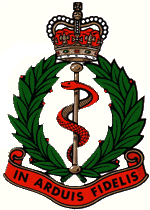181st (Airlanding) Field Ambulance
| 181st (Airlanding) Field Ambulance | |
|---|---|

|
|
| Active | 1941–1945 |
| Country | United Kingdom |
| Branch | British Army |
| Type | Medical |
| Role | Airborne forces |
| Size | Field Ambulance |
| Part of | 1st Airlanding Brigade |
| Engagements |
Operation Biting Operation Ladbroke Operation Slapstick Battle of Arnhem Operation Doomsday |
| Insignia | |
| Airborne forces emblem |
 |
The 181st (Airlanding) Field Ambulance was a Royal Army Medical Corps unit of the British airborne forces during the Second World War.
The Field Ambulance was assigned to the 1st Airlanding Brigade, the glider borne element of the 1st Airborne Division. Some men of the unit took part in the first parachute raid on the French coast in 1942. The unit then moved to Tunisia for operations in the Mediterranean theatre.
During Operation Ladbroke, part of the Allied invasion of Sicily, a shortage of gliders resulted in only six, instead of the required thirty, being allocate to the Field Ambulance. Of those six, only one reached land the others crashed into the sea. They were next deployed during the Allied invasion of Italy in Operation Slapstick. Soon afterwards the Field Ambulance returned to the United Kingdom, then in September 1944, they landed by glider in the Netherlands. In the battle of Arnhem the Field Ambulance remained behind with the wounded, and he majority of its men became prisoners of war.
The 181st (Airlanding) Field Ambulance was reformed after Arnhem, and were sent to Norway at the end of the war to assist in the repatriation of the German forces. The 1st Airborne Division including the 181st (Airlanding) Field Ambulance were disbanded after serving in Norway.
Impressed by the success of German airborne operations, during the Battle of France, the British Prime Minister, Winston Churchill, directed the War Office to investigate the possibility of creating a corps of 5,000 parachute troops. In September 1941 the 1st Parachute Brigade began forming, soon after followed by the glider borne 1st Airlanding Brigade and the 1st Airborne Division. In keeping with British Army practice at the same time as the infantry battalions were forming, airborne supporting arms were formed including Royal Army Medical Corps units. Of the seven airborne field ambulances formed during the Second World War, two were glider borne the 181st and the 195th. While the other five were parachute trained the 16th, 127th, 133rd, 224th and the 225th.
...
Wikipedia
